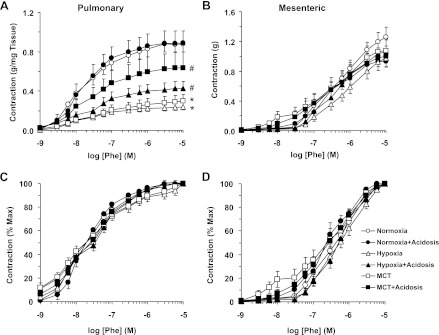Fig. 3.
Phenylephrine (Phe)-induced contraction in pulmonary artery (A and C) and mesenteric artery (B and D) of normoxic, hypoxic, and MCT-treated rats with or without treatment with NH4Cl (acidosis). Pulmonary artery and mesenteric artery rings were stimulated with increasing concentrations of Phe. The contractile response was measured and presented in g/mg tissue weight (A) or in g (B) or as % of maximum Phe contraction (C and D). Data represent means ± SE (n = 6–8) *Measurements in hypoxia or MCT-treated rats are significantly different (P < 0.05) from corresponding measurements in control normoxic rats. #Measurements in NH4Cl-treated (acidosis) rats are significantly different (P < 0.05) from corresponding measurements in hypoxia or MCT-treated rats without NH4Cl treatment. Max, maximum.

